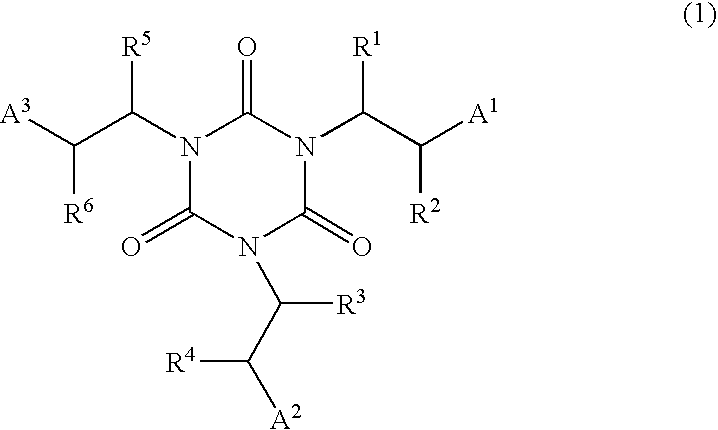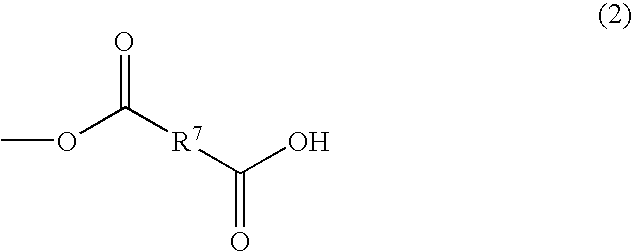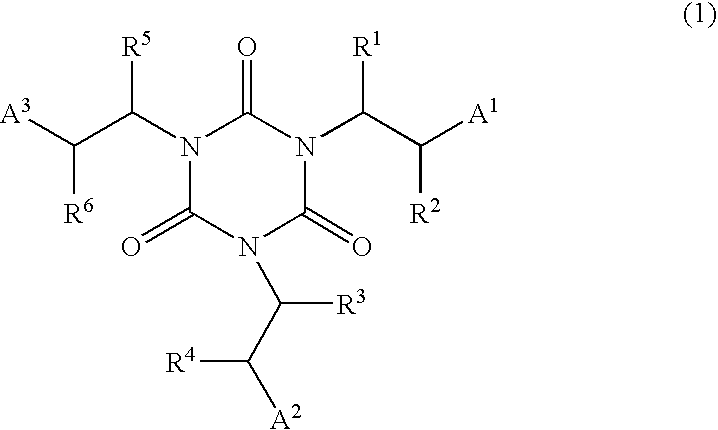Heat-Resistant Water-Soluble Flux Composition for Soldering
a technology of water-soluble flux and soldering, which is applied in the direction of soldering apparatus, manufacturing tools, welding/cutting media/materials, etc., to achieve the effect of not impairing heat resistan
- Summary
- Abstract
- Description
- Claims
- Application Information
AI Technical Summary
Benefits of technology
Problems solved by technology
Method used
Image
Examples
synthetic example 1
Synthesis of tris(2-hydroxyethyl)isocyanurate (Reaction Product A)
[0044] In an autoclave, 38.7 g (0.3 mol) of cyanuric acid, 39.6 9 (0.9 mol) of ethylene oxide, 150 g of 2-methoxy ethanol and 0.53 g of triphenylethyl phosphonium bromide were added, then the atmosphere therein was replaced with nitrogen, the autoclave is immediately dipped in an oil bath heated to 127° C. with stirring, and the reaction was carried out under self-vapor pressure for 14 hours after the internal temperature of the autoclave reaches 120° C. After the completion of the reaction, the reaction product is transferred in an egg-plant flask equipped with a thermometer, and the solvent is distilled off with a vacuum evaporator. Finally, the solvent was distilled off at 130° C. / 666.61 Pa or less for 30 minutes to obtain 77.5 g of tris(2-hydroxyethyl)isocyanurate in powdery state.
synthetic example 2
Synthesis of tris(2-hydroxypropyl)isocyanurate (Reaction Product B)
[0045] In an autoclave, 129 g (1.0 mol) of cyanuric acid, 177 g (3.05 mol) of propylene oxide, 129 g of 2-methoxy ethanol, 1.29 g of triphenylethyl phosphonium bromide and 1.29 g of 35% hydrochloric acid were added, then the atmosphere therein was replaced with nitrogen, the autoclave is immediately dipped in an oil bath heated to 127° C. with stirring, and the reaction was carried out under self-vapor pressure for 20 hours after the internal temperature of the autoclave reaches 120° C. After the completion of the reaction, the reaction product is transferred in an egg-plant flask equipped with a thermometer, and the solvent is distilled off with a vacuum evaporator. Finally, the solvent was distilled off at 110° C. / 666.61 Pa or less for 60 minutes to obtain 302 g of tris(2-hydroxypropyl)isocyanurate in powdery state.
synthetic example 3
Synthesis of succinic anhydride Addition Product (Reaction Product C) of tris(2-hydroxyethyl)isocyanurate
[0046] In a 1 L 4-neck round-bottomed reaction flask equipped with a thermometer and a condenser, 100 g (0.383 mol) of tris(2-hydroxyethyl)isocyanurate synthesized in Synthetic Example 1, 113.7 g (1.137 mol) of succinic anhydride, 2 g of triethyl amine and 400 g of acetonitrile were placed, and the flask was dipped in an oil bath at 85° C. and stirred. The molar ratio of (succinic anhydride) / (hydroxy group) was 0.989. After the temperature reached the reflux temperature, the reaction was carried out for 2 hours, then acetonitrile was distilled off with a vacuum evaporator. The resulting liquid product was subjected to recrystallization in ethyl acetate to obtain 203 g of a crystal having a melting point of 108° C. The resulting crystal had an acid content of 5.33 eq / kg that almost corresponds to the theoretical acid content of 5.35 eq / kg. The HPLC analysis also showed single 3-a...
PUM
 Login to View More
Login to View More Abstract
Description
Claims
Application Information
 Login to View More
Login to View More - R&D
- Intellectual Property
- Life Sciences
- Materials
- Tech Scout
- Unparalleled Data Quality
- Higher Quality Content
- 60% Fewer Hallucinations
Browse by: Latest US Patents, China's latest patents, Technical Efficacy Thesaurus, Application Domain, Technology Topic, Popular Technical Reports.
© 2025 PatSnap. All rights reserved.Legal|Privacy policy|Modern Slavery Act Transparency Statement|Sitemap|About US| Contact US: help@patsnap.com



